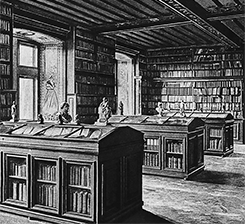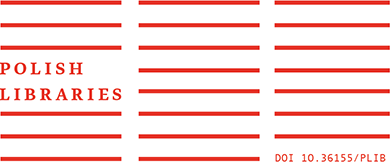ALL ISSUES

CREDITS / TABLE OF CONTENTS, p. 2–3
ARTICLES
The National Library of Poland and KABA subject heading languages and their evolution towards National Library of Poland descriptors, p. 7–63
The modern post-coordinated indexing language developed and used by the National Library of Poland since 2017 – the National Library of Poland Descriptors (NLPD) – replaces the traditional pre coordinated subject heading language of the National Library of Poland (SHL NLP). The vocabulary of NLPD is further enriched by transforming subject heading descriptions from the pre-coordinated subject heading language KABA (SHL KABA). Transforming a pre-coordinated into a post-coordinated language primarily involves getting rid of the syntax used in the precoordinated language to rank the subject headings in a catalogue giving metadata in index form. The facetted presentation of the post-coordinated system allows the use of any desired combination of concepts. The first stage in transforming the pre-coordinated languages in question is identifying the meanings expressed by the syntax (the position of lexical units determines their meaning) and recorded in MARC 21 format, originally created to meet the needs of card catalogues. For meanings generally referring to the subject matter of publications, we must distinguish elements such as simple, detailed subjects, implied subjects, the “aspect” (Polish: ujęcie) of subjects and different types of relationships between subjects. Correctly identifying these meanings enables us to move on to the second stage of the transformation process, which is recording those meanings as lexical units that can be used freely in NLPD.
KEYWORDS: National Library of Poland descriptors (NLPD), subject heading language transformation, pre-coordinated language, post-coordinated language, National Library of Poland (SHL NLP), KABA, MARC 21, syntax of pre-coordinated language, grammar of pre-coordinated language
Identifying samples of historical handwriting via image processing with the help of characteristic features of the author’s handwriting, p. 64–98
This article presents the architecture of a system for automatically identifying samples of handwriting. The system allows for
the fact that acquiring images is particularly difficult from Latin manuscripts due to the specific nature of such texts, and successfully extracts only such information as is necessary to analyse the features of the handwriting in the sample. The system proposed here is not only able to recognise correctly samples of a single author’s handwriting in different scales, but also, after appropriate modification, to identify the features of the handwriting in which the text was written. This can also help with an initial assessment of the date when the text in question was created.
KEYWORDS: handwriting identification, Hough transform, scale invariant feature transform, pattern recognition, projection profilesRzewuski‘s travels with Golius, p. 100–113
There is no doubt that Wacław Seweryn Rzewuski was one of the most colourful personages of Polish Romantic era. In spite of numerous accounts of his life and work, still little is known about his travels and adventures. His own reports thereof are particularly conventionalized and purposefully mythologized, and cannot be trusted unconditionally if one wants to establish the truth. Therefore, the present article aims at deconstructing the legend enshrouding Rzewuski. Its author analyzes some of the linguistic aspects of Rzewuski’s Sur les chevaux orientaux et provenant des races orientales, which is both a record of his travels in the Middle East and a treatise on oriental horses. Special attention is given to how Rzewuski was influenced by Jacobus Golius, the author of one of the most popular Arabic-Latin dictionaries, not only as far as linguistic questions are concerned, but also regarding the life and culture of contemporary Arabs. This analysis makes it possible to hypothesize about the circumstances of the creation of the treatise and about the creative process itself, in order to revise our understanding of his work.
KEYWORDS: Wacław Seweryn Rzewuski, Sur les chevaux orientaux, Concerning the Horses of the Orient, Jacobus Golius, Lexicon arabico-latinumArchives of the Prussian State Library in Berlin in the collections of the Jelenia Góra department of the State Archives in Wrocław, p. 114–139
In the Jelenia Góra department of the State Archives in Wrocław is stored a small part – consisting of 60 archival units – of the current records (Registratur) of the Prussian State Library in Berlin (Preußische Staatsbibliothek) from the years 1939–45. It is a remnant of the office of the Berlin library: catalogue and acquisition departments which operated in the foothills of the Karkonosze mountains in the last months of the Second World War. The first main group of files contain correspondence regarding the mandatory copy (5–14, 23, 24, 27, partly 25 and 28). Along with the transfer of the acquisition department to Jelenia Góra, correspondence regarding the mandatory copy was sent as well. Files preserved in Jelenia Góra can be divided into three groups: concerning the official prints from 1936–1944, correspondence with the military authorities, bulletins and newspapers published in prisoner-of-war camps. The second main group consists of files illustrating the process of obtaining by the Berlin library of manuscripts and prints during the war apart from the mandatory copy (numbers 15–22). These files can be divided into two categories: correspondence with civil institutions as well as military and police authorities of the German state. The aim of this article is firstly to present the archival fonds “Prussian State Library Department in Jelenia Góra” and to indicate its historical value; secondly, to discuss issues that complement our knowledge on the Berlin library’s war activities in the field of acquisition; thirdly – perhaps most importantly – to show clues for further archival searches.
KEYWORDS: Second World War; cultural policy of the Third Reich; Prussian State Library in Berlin; Off-site centre in Jelenia Góra (Hirschberg)Publishing across borders: the Polish discussion of literary property and copyright in the era of the Berne Convention, p. 140–160
The article deals with the Polish discussion of literary property and copyright in the second half of the 19th century. Because of the partitions, Polish publishers in that era were subject to different legal systems (Russian, Prussian, and Austrian) while the Polish language publishing market was divided by customs borders. On the other hand, there was a flourishing cooperation between Polish publishers based on unwritten customary publishing practices that were observed across borders. In contrast to countries with more developed and concentrated publishing markets, there were no significant differences in the views of Polish publishers on literary property or the duration of copyright protection. In the international debate on the protection of translations, Polish publishers, lawyers, and also writers usually opposed the full protection of translations because they saw it as a threat to the development of Polish culture, which depended on access to world literature and science.
KEYWORDS: Copyright history, literary property, publishing history, Berne Convention, Polish culture, 19th centuryMusic in Warsaw on gala days of 1815–1850, p. 162–218
The article presents a concise description of the repertoire performed in the years 1815–1850 on public court holidays, the so called “gala gays”, organized by the imperial Romanov dynasty, the then rulers of the Kingdom of Poland. While there are no publications on the subject, these celebrations influenced deeply the whole scope of everyday life of different groups of people living in Warsaw. The sources for this description were Warsaw press and calendars, as well as available research literature on the musical culture in Warsaw at the time. The author presents a general description of the celebrations, their participants, venues and durations and occasions on which they took place. The author also discusses the reasons why Polish composers and performers actively participated in such events. He quotes almost unknown press materials that enlarges our understanding of the musical culture of Warsaw under partition and provides information about the output of the most outstanding composers of the time: Józef Elsner and Karol Kurpiński. Similarly, he names the performers (professional and amateur artists, choirs, orchestras etc.), as well as venues (churches and synagogues, theatres, ballrooms etc.), their public, genres, and indicates the differences in the celebrations after the ill-fated November Uprising (1830). Given that the artistic character of specific celebrations was related to the peculiarities of Russian court etiquette, the choice of particular repertoire and performers was not always determined by their objective esthetic value. Both before and after the Uprising typical of such celebrations were the performances of occasional cantatas, which were performed only once and have not been
preserved until today. The opera repertoire at the celebrations was typical of Europe in the 1st half of the 19th century. Gala polonaises, especially those written by Kurpiński, despite their occasional character, were profoundly emotional and representative of the Polish spirit of this dance. The introduction of singing classes to the state-operated schools made it easier to write and perform valuable vocal sacred music, including the works of contemporary European composers.
KEYWORDS: Music in the Polish Kingdom, musical culture of Warsaw in 1815–1850, gala days, Józef Elsner, Karol Kurpiński

